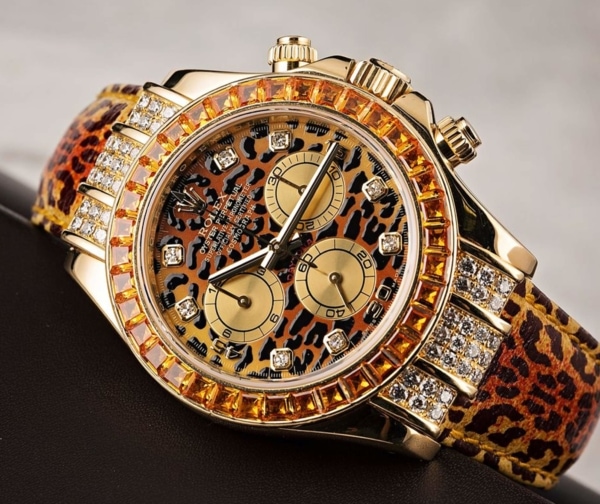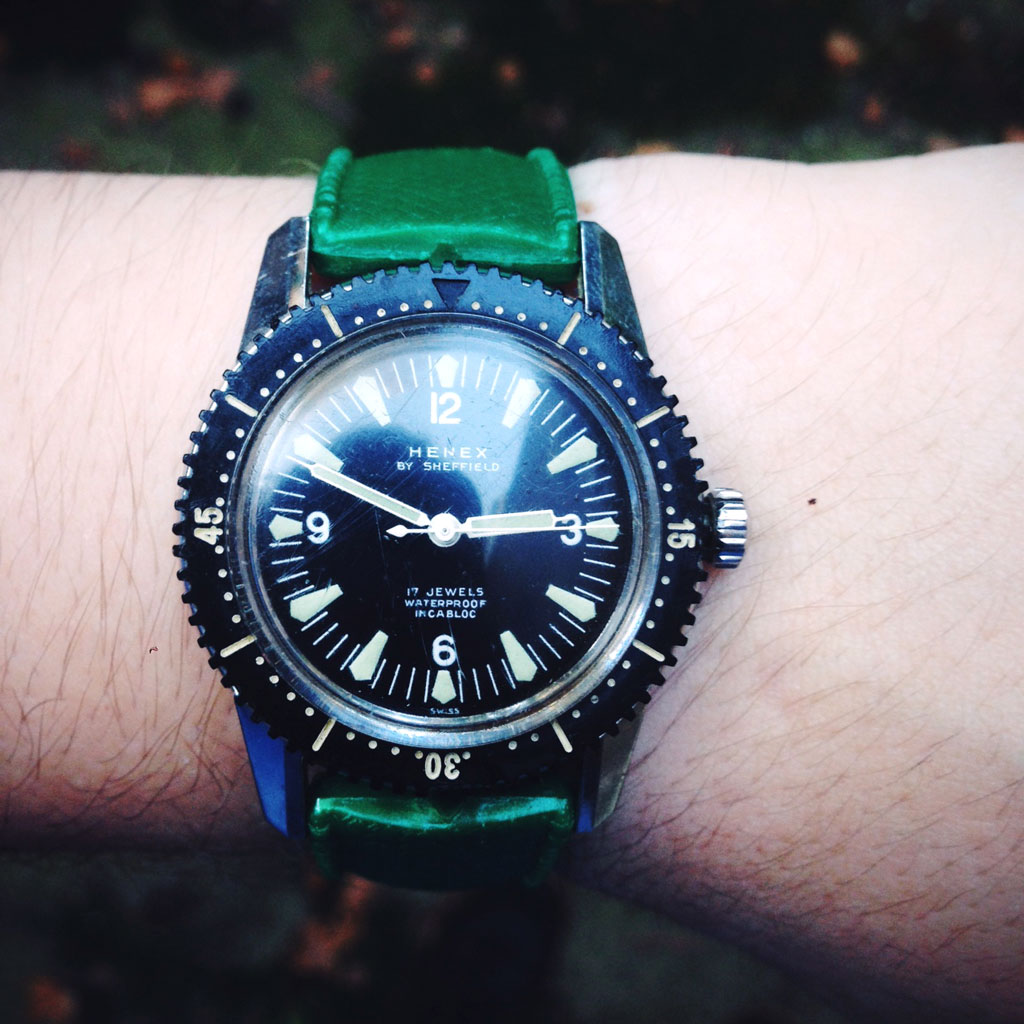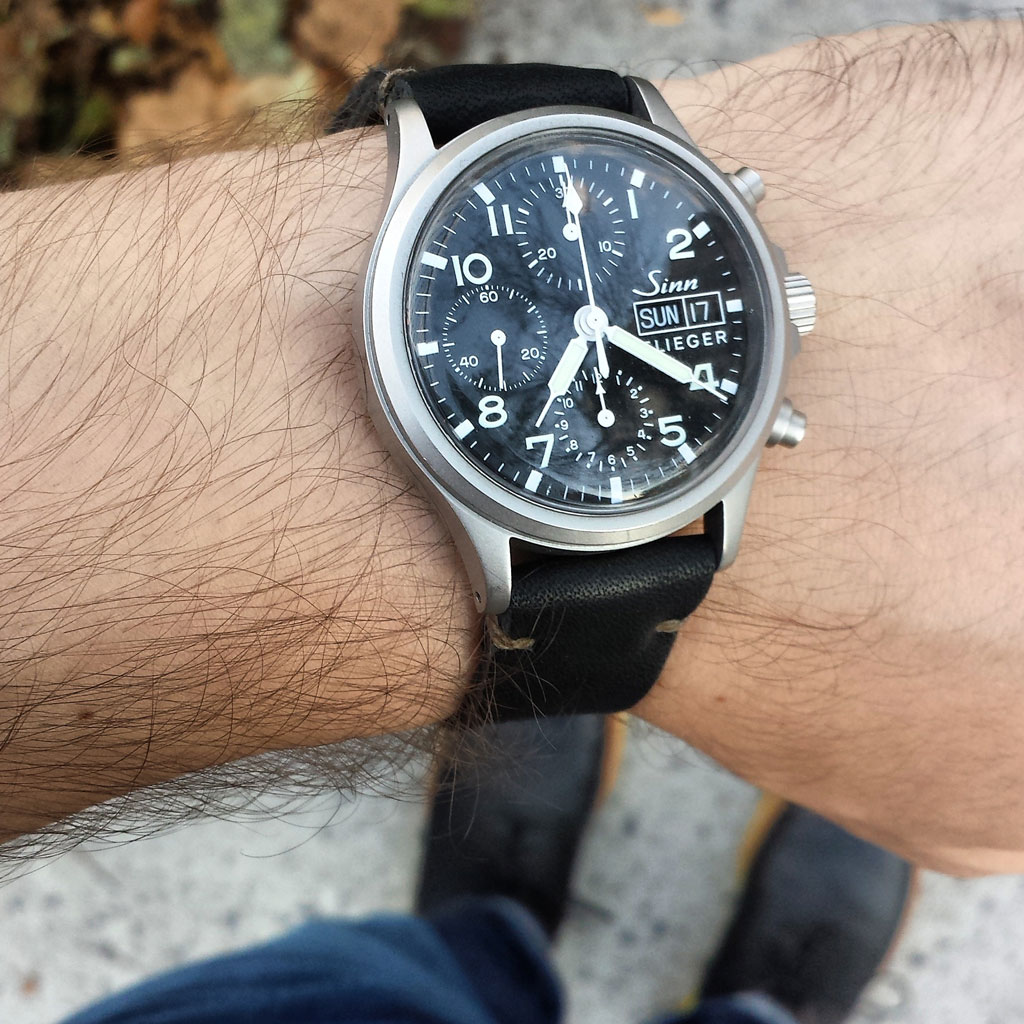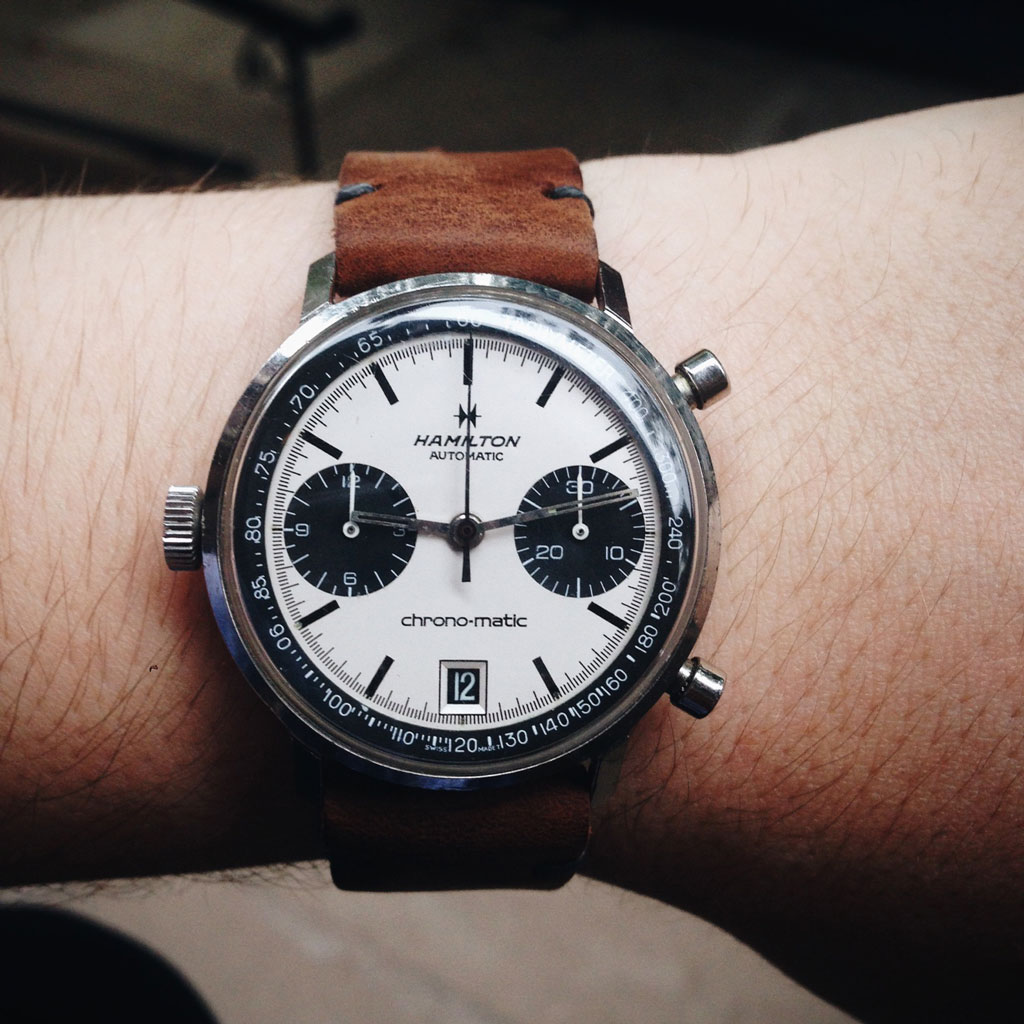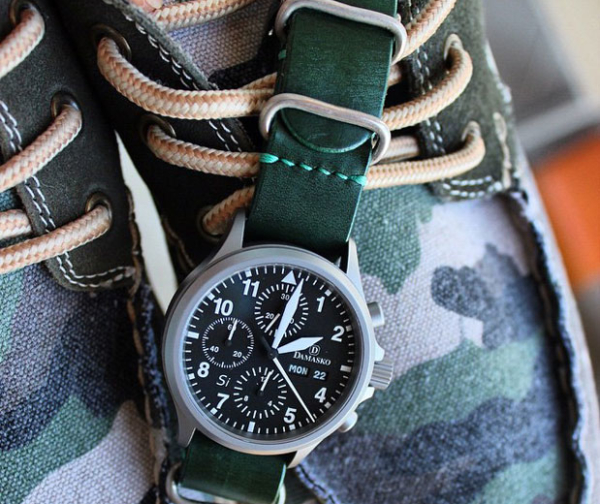Welcome to our first w&w Round-Table! The idea for this new series is simple; the w&w team will all be asked the same question and respond accordingly. No one sees each other’s answers until the post goes live. The questions we have planned will range from ones pertaining to personal taste, to opinions on watch-news, to…well, anything we think will be fun to answer. Since I’m sure w&w readers will all have answers of their own, I encourage you to respond in the comments as well. Also, feel free to email us Round-Table question ideas via our Contact Page. Enjoy!
Question: If you could only keep one watch from your collection, what would it be and why?
James Enloe:
My Omega Seamaster Chronograph would be my one watch, should it come down to that. In the past, this question was always more difficult to answer for one reason or another. But since acquiring this piece I can now answer without hesitation. It’s versatile, accurate, has the functions I want, and it’s the perfect size. I will admit that many of my watch purchases in the past have been more spur of the moment than anything, but with this watch I knew what I wanted. I put in the time to wait for the right piece at the right time before buying. And it was bought for a special occasion: my 40th birthday.
Sean Lorentzen:
If I could only keep one? This is like asking me to part with a child… But if I could keep only one out of my current collection, I’d have to hang on to my Seiko 6138-8039. It may not be the most expensive watch in my collection, or even the one in the best condition, but it’s not just a timepiece to me, it’s a part of who I am. I’ve written about this one before here on w&w, and I’m a huge fan of the design. It’s simultaneously a product of its era and completely timeless, and no other company before or since has dared to go in quite the same direction. Add in the subtle homage to one of the greatest teams in Formula 1, Team Lotus, and it’s a sure deal. Not to mention it’s the watch my father gave me for my 21st birthday. I couldn’t possibly let it go.
Ed Estlow:
It’d have to be my Omega Speedmaster 3570.50. There are several reasons why. I’m a space geek. I have a degree in Aerospace Engineering and I bought the watch for myself for my 50th birthday as a fitting symbol of my interest in the space program. The watch is legendary for its role as the first watch on the Moon, its use in timing the rocket burns that brought Apollo 13 safely back to Earth, and as still the only watch that NASA has approved for EVA (extra-vehicular activity). Oh, and as a chronograph it’s just about perfect – the right size, highly legible, and has an everything-you-need, nothin’-you-don’t ethos.
The Watch Curmudgeon:
That’s a horrifying question for someone who has so many fine and interesting watches. Which one is my favorite? That would have to be the one I choose to wear on any given day. They’re ALL my favorites! But, alas, I’m impelled to make a choice. So, I would go back to my watch addiction roots and select one I received from my grandparents in 1963: a simple, time-only Henex by Sheffield diver’s compressor. It’s a very old, reliable friend with just too many great memories attached to it. Sorry Rolexs, Tourby, GP, Tutima, Chronoswiss, MeisterSinger, Omega, Muhle and so many others!
Christoph McNeill:
The answer for me on this one is easy. I’d keep my 1970 18k gold Rolex President 1803 on original bracelet. It’s not because it’s valuable, and it’s not really my style, but this one is special to me because it’s a family heirloom. It originally belonged to my grandfather, and my dad inherited it when he died. My dad knows I collect and appreciate watches, so for my 40th birthday, he gifted it to me! I was very surprised, as I had no idea he was going to do this. The watch originally had my grandfathers name engraved on the back, and my dad had his initials and my initials engraved to match. So now it bears the mark of three generations of my family. Definitely a keeper!
Mark McArthur Christie:
OK, it’s firmly a first world problem, but this is a real, serious, tourbillon of a dilemma. The easy question is “which watches would you leave behind?” Deciding which one to keep is much harder.
So, let’s make it objective with three selection criteria:
– It has to be irreplaceable
– It has to have some sort of historical angle
– It has to have some horological importance
In which case, I nominate my 1964, gilt-dial Rolex 1016 Explorer I.
Every 1016 is old enough to have picked up enough wabi to be irreplaceable. The case on mine has never been polished, so it looks as though someone’s kept it in a toolbox with their spanners, hex keys and a few rusty bolts. But that’s the charm. It’s not like one of those poor, over-restored, over-priced, ‘investment’ watches that have had all the soul and joy polished out of them. It’s battered, bashed and better for it. I’ll never find another like it. And it was my first vintage Rolex.
The gilt printing on the gloss black dial makes every watch a one-off too. Each gilt-dial 1016 is slightly different because of the way the lume decays over time. Some are pitted and crazed, others still smooth and with a gloss deep enough to see your face to shave with. I’m fortunate in that the dial on mine is still thick, slick and dark, setting off the gilt writing a treat.
The forerunner of the Explorer I (probably a 6350) went up Everest on Tenzing Norgay’s wrist (Hillary wore a Smiths Deluxe). These watches started a trend for rugged, tough precision timepieces – the first deliberate ‘tool watches’. Ian Fleming, the creator of James Bond wore a 1016. In fact, there’s some evidence he wrote a 1016 on a steel bracelet onto 007’s wrist too. A watch belonging to the originator of one of the most successful book and film franchises ever has to rate pretty near the top on the historical scale.
And the 1016 was the longest running model in the Rolex lineup. In various forms they made the 1016 from 1963 to 1989. In this time it underwent more changes in movement (two versions of the cal. 1560 alone), dial and hands to keep even the finickiest, most obsessional horologist happy. The 14270 which replaced it carried the name and design features (the inverted triangle at 12, clear arabic numerals at 3, 6 and 9) but, in my view, has never had the charm of the original.
So, if I was backed into a corner and forced to just keep one watch, on those criteria, the 1016 has to be it.
Brandon Cripps:
Like any watch collector, I would have a really hard time trimming my collection down to a single watch! For the sake of the discussion, I’ll exclude the watches that I keep for nostalgic or sentimental reasons – my dad’s DW-5200 G-Shock, my great-grandfather’s Elgin pocket watch – and think about this question as “If you could only wear one watch forever….” And that makes it pretty easy: my Sinn 356.
The 356 has everything I want in an everyday watch in one perfect little package. It’s simple, functional, timelessly-styled, tough, and looks good in any setting. Flieger chronographs have looked good for 75+ years, and the 356 carries on the tradition well. Sinn’s exceptional German manufacturing makes the 356 a real go-anywhere watch. It dresses up nicely on leather and looks perfectly at home on a NATO – mine’s usually found on mesh. I’ve worn it to a wedding and a war, and it’s always felt like the right watch.
Li Wang:
Miles Davis described his personal style as “clean as a broke-dick dog.” It’s also an apt description of the MKII Nassau, my choice for the one watch I’d keep. At under 40mm, with a no-date dial and no crown guards, the Nassau nails all my criteria for the perfect dive watch. It’s straight-up handsome.
The red triangle at the top of the bezel insert provides just enough flair. I wear mine on a NATO with shoulder-less Marathon spring bars, which gives it that fixed lug look and feel. It’s my one watch that elevates everything else I’m wearing.
Ilya Ryvin:
When it comes to inanimate objects, I’m not much of a sentimentalist. Having said that, there is one watch I’d have a hard time letting go, and it would definitely be the last one on the chopping block if I had to reduce my collection. Not because it’s particularly rare or expensive (in fact, it was a relative bargain) or, as stated above, it holds some sort of deep-seated value. If you follow my Instagram feed, then you probably already know the watch: my Sinn 356.
I picked up the 356 second-hand a few years ago. I had admired the 356 from afar, but having never actually handled one in person, I wasn’t serious about buying it sight unseen. At the time, I had saved up some money intending to buy a new watch (either a Sinn 556i or a Damasko DA36), when a 356 hit the forums at a price that was too good to pass up. The seller checked out and the condition of the piece was good enough, so I shrugged and went for it, quickly forgetting my qualms about buying something “sight unseen.” (Really, the price was THAT good.)
As soon as I got the watch on my wrist, any lingering buyer’s remorse quickly abated and I understood all the fanboy love. The perfect size, the military styling, the robust build; the 356 had it all. It became my most worn watch (the scratches and dings are proof of that claim), and more often than any other piece in my collection it puts a smile on my face when I strap it on. It looks great on its gorgeous H-link bracelet, a NATO strap, or a leather two-piece, and I’d feel comfortable pairing it with most outfits for any occasion. I could probably even take it into the pool, though I’m not one for wearing a watch in water. Regardless, that sort of versatility is hard to beat. So, hands-down, the 356 would be my one watch if I were forced to choose. Though, as I’m sure most other WIS would agree, what a frightening choice to have to make.
Blake Malin
At first, I thought I’d hold on to my Sinn 103 St. I bought it new, and it was the first fairly expensive watch I’d ever purchased at around $1,800, so it has a lot of sentimental value. I love that watch. But the more I thought about the question of what watch would I truly want to wear everyday, I kept coming back to my Tudor Pelagos. I picked up the Pelagos fairly recently, and it’s occupied most of my wrist time ever since. I could go on about its build quality (made in Rolex factories) and practicality (highly legible and made of lightweight titanium), but the fact of the matter is that there is just something about this watch. It balances style and wearability perfectly and has a feel that drew me in immediately. It’s also the watch I own that most often starts a conversation amongst fellow watch nerds. So, for its quality, durability, aesthetics and intangible awesomeness, I’d chose my Tudor Pelagos as my one watch to keep from my current collection.
Zach Weiss:
Certainly a tough question, but when it comes down to it, only one watch in my collection fulfills all the necessary criteria: my 1969 Hamilton Chrono-Matic. My favorite thing about watches in general is that they lay at the crossroads of so many things; history, engineering, graphic design, product design, fashion, style, etc… they are embodiments of stories as much as they are wrist wear. The ’69 Chrono-matic, more than any of my other watches, checks all of these boxes.
To start, it’s really cool looking. A definitive panda with black sub-dials at 3 and 9 and a white on black date at 6. Nice, bold black markers for the hours and a black chapter ring make the dial pop. Since it’s 45 years old, it also has a slight brown patina to it, adding character. It’s wonderful to wear at 36.5mm with a bizarre height of 15mm, most of which is the huge domed acrylic crystal. From a design standpoint, the small size works exceptionally well with the dial layout, for an overall balanced and compact feel. It makes modern day monster watches look like a mess. Style-wise It’s sporty and graphic, but in a way that isn’t trying too hard.
But that’s just the outside. On the inside it’s powered by the famed Calibre 11 automatic chronograph, one of the first three auto-chronos to hit the market in 1969, alongside the Zenith El Primero and the Seiko 6139, which was a joint effort between Breitling, Heuer, Buren (which Hamilton partially owned) and Dubois-Depraz. It’s a modular chronograph featuring one of Buren’s micro-rotor automatic movements under a chronograph module (also adding to its height) with the signature crown at 9, pushers at 2 and 4 alignment. This touch of asymmetry gives it a quirky personality that one just doesn’t find anymore, certainly not at Hamilton.
So, needless to say, I love the damn thing. It’s gorgeous, interesting and rare. It’s the kind of watch I could wear everyday and never get sick of. It’s also one of the watches in my collection that when a non-watch person asks me about, they quickly regret it, as there is so much to get into, yet when a WIS sees it, they immediately want to talk about it. For more info on the Caliber 11, read Jeff Stein’s great article Project 99









 Featured Videos
Featured Videos


